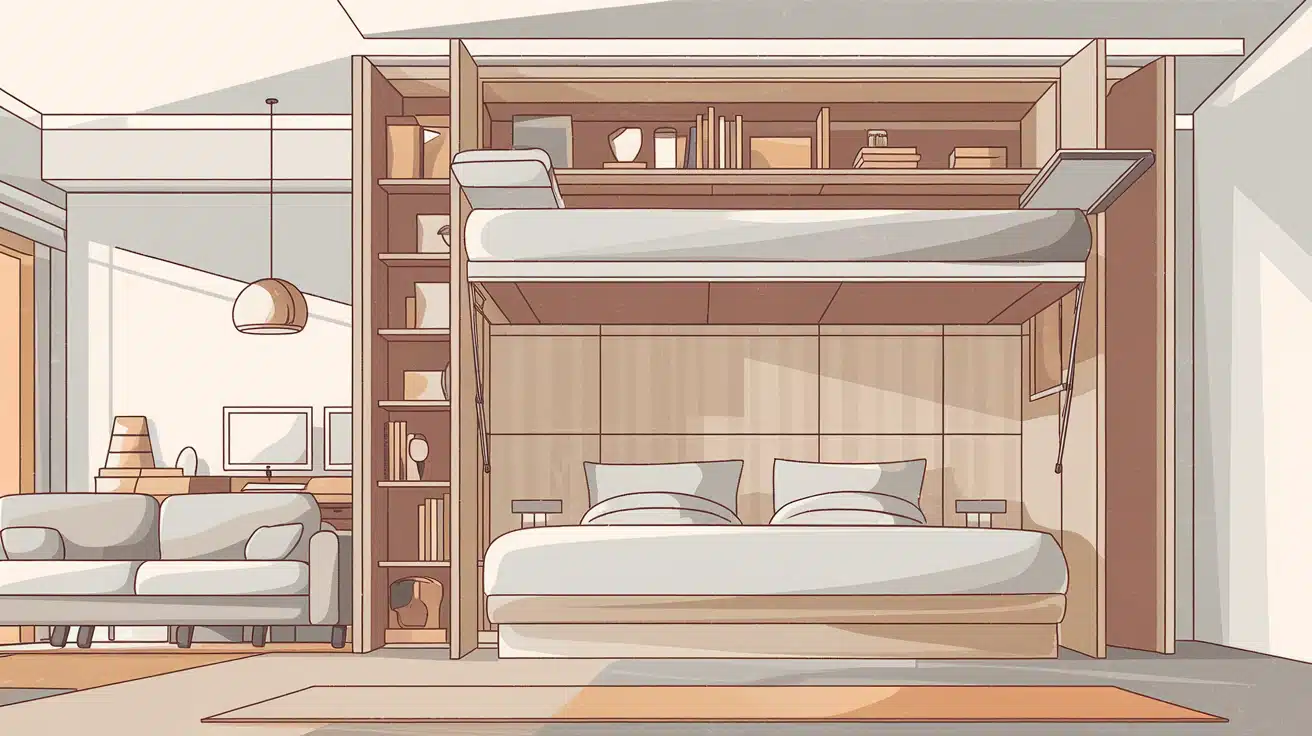Altering living spaces has become my passion, and I’ve found Murphy beds to be one of the most practical investments for maximizing square footage.
As a home design enthusiast, I’ve extensively researched to understand what really goes into the cost of these versatile furniture pieces.
When I first considered installing one, I was shocked at some of the price tags! But after swooping deep into research (and making a few mistakes along the way), I’ve cracked the code on getting the most bang for your buck.
Whether you’re creating a multi-functional guest room or maximizing space in a studio apartment, I’ll walk you through everything from basic pricing to hidden expenses.
Why Would Anyone Want a Wall-Hiding Bed Anyway?
Spoiler alert: Murphy beds are basically space-creating magic wands. Here’s why they’re worth considering:
- Space Wizardry – Imagine reclaiming 30+ square feet of floor space with a simple push. That’s basically a walk-in closet worth of room!
- Swiss Army Knife Living – Your bedroom can moonlight as a yoga studio, home office, or dance floor (judgment-free zone here).
- Adulthood Achievement Unlocked – Nothing says “I’ve got my life together” like furniture that converts.
- Surprise Factor – The look on friends’ faces when you reveal your secret bed is priceless.
- Resale Advantage – In urban markets, a Murphy bed can be a standout feature for potential buyers or renters.
The Price Tag Breakdown: What Are You ACTUALLY Paying For?
Let’s cut to the chase – Murphy beds aren’t cheap. But understanding where your money goes helps make the investment less painful.
The Base Cost: Size Matters
| Size | Price Range | Best For |
|---|---|---|
| Twin | $1,500-$4,000 | Kids, guests, smaller spaces |
| Full | $2,000-$5,000 | Single adults, compact rooms |
| Queen | $2,900-$6,500 | Couples, primary bedrooms |
| King | $3,500-$15,000 | Luxury lovers, spacious rooms |
The price jumps between sizes aren’t just about the extra materials – larger Murphy beds require stronger mechanisms and more robust mounting systems to safely support the additional weight. A queen mattress alone can weigh 150+ pounds before you even add the frame and cabinet!
Installation: DIY or Call the Pros?
DIY Warrior Path:
- Savings: $250-$1,000 in labor costs
- Time Investment: One weekend + YouTube University degree
- Tool Requirements: Stud finder, drill, level, and a patient partner/friend
- Risk Level: Medium to “How do I explain this hole in my wall to my landlord?”
- Satisfaction Level: Immense pride when you successfully complete it
Professional Route:
- Cost: $250-$1,000 (more for complex jobs)
- Peace of Mind: Priceless
- Time Saved: Enormous (2-4 hours of installation vs. your entire weekend)
- Relationship Saver: Significant other won’t witness your colorful language as you struggle with wall anchors
- Warranty Benefits: Many installers guarantee their work for 1-2 years
When I had my Murphy bed installed, the professionals finished in under 3 hours and even touched up minor wall damage. They also adjusted the tension mechanism perfectly – something I would have struggled with on my own.
The REAL Cost Factors (That No One Tells You About)
The Murphy Bed Family Tree
- The Classic Wall-Hugger ($1,500-$3,000)
- Traditional vertical fold-up
- No bells and whistles
- Still transformative for your space
- Typically includes basic cabinet facing or crown molding
- Usually requires wall mounting
- The Multitasker ($3,000-$5,000)
- Includes desk or shelving components
- Perfect for home office/guest room combos
- Your Zoom colleagues will never know you’re calling from your bedroom
- Often features integrated lighting options
- Some models include pull-out nightstands
- The Showstopper ($4,000-$10,000+)
- Custom cabinetry that matches your décor
- Premium materials like solid walnut or cherry
- Potentially includes lighting, USB ports, even remote controls
- Definitely earns you bragging rights
- Often features soft-close mechanisms
- May include customized storage solutions on either side
- The Renter’s Friend: Cabinet Beds ($700-$2,500)
- No wall attachment needed
- Less dramatic transformation but still space-saving
- Take it with you when you move
- Landlord will never know your furniture-hacking ways
- Often features storage drawers underneath
- Usually fits a twin or full mattress, rarely queen
I started with a basic wall-hugger model in my first apartment and upgraded to a multitasker in my current home. The difference in functionality has been substantial, but both served their primary purpose of freeing up floor space admirably.
Hidden Costs That Might Surprise You
Don’t get caught with your wallet unprepared:
- Wall Reinforcement: If your walls aren’t solid enough ($150-$400)
- Electrical Work: For integrated lighting ($150-$300)
- Flooring Protection: Because no one thinks about this until it’s too late ($50-$150)
- Mattress Purchase: Most kits don’t include one! ($300-$1,200)
- Furniture Removal: Getting rid of your old bed ($100-$300)
- Seasonal Maintenance: Mechanism lubrication and hardware tightening ($50-$100 annually)
- Special Linens: Some Murphy beds require specific sheet tucking techniques ($50-$100)
- Specialty Hardware Replacements: If something breaks outside of warranty ($75-$200)
When budgeting, I always recommend adding 15-20% to your expected total for these unexpected expenses. Better to be pleasantly surprised than financially stressed!
Quality Matters: What Separates Budget from Premium Options
Mechanism Differences Worth Knowing
The heart of any Murphy bed is its lifting mechanism, and there are significant differences:
- Spring Mechanisms: Traditional, affordable, but require occasional adjustment
- Piston Systems: Smoother operation, require less maintenance, last longer
- Counterbalance Systems: Premium feel, easiest to operate, longest lifespan
I’ve tried all three in different settings, and while the spring mechanism in my first Murphy bed worked fine, the piston system in my current one operates with significantly less effort – important when you’re tired at the end of a long day.
Cabinet Construction Quality Indicators
Look for these features when comparing options:
- Full Plywood Construction vs. particle board (doubles the lifespan)
- Dovetail Drawer Joints vs. stapled corners (indicates overall quality)
- Soft-Close Hinges vs. standard hinges (prevents slamming)
- Thickness of Facing Materials (3/4″ is ideal vs. 1/2″ on budget models)
- Weight Capacity (quality beds support 1,000+ pounds vs. 500 pounds for budget options)
“The difference between a $1,500 and $3,000 Murphy bed often isn’t visible at first glance – it’s in these construction details that determine whether it lasts 5 years or 20 years.”
Money-Saving Hacks From a Murphy Bed Veteran
After helping three friends install their Murphy beds (and installing two of my own), I’ve learned some tricks:
Strategic Shopping
- January and July are the golden months for furniture sales (20-30% off if you time it right)
- Floor models can be discounted up to 40% (just check the mechanism works smoothly)
- Bundle deals often include free or discounted installation
- Last year’s models typically drop in price when new catalogs come out
- Warehouse sales from manufacturers can offer 25-50% savings
- Holiday weekends almost always feature furniture promotions
I found my current Murphy bed during a President’s Day sale at 35% off the regular price, which saved me nearly $1,200.
Smart Design Choices
- Simpler mechanisms (spring vs. piston systems) can save $200-300
- Standard sizes are always cheaper than custom dimensions
- Laminate finishes look surprisingly good these days at half the cost of real wood
- DIY the cosmetic elements (cabinet doors, trim) while professionally installing the mechanism
- Skip integrated lighting – add battery-powered options later for 75% savings
- Choose a universal design that won’t look dated in five years
Is a Murphy Bed Worth the Investment? Let’s Do the Math
The Cost-Per-Use Calculation
A quality Murphy bed typically lasts 15-20 years. Let’s break that down:
- $3,500 bed ÷ 15 years = $233/year
- $233 ÷ 365 days = $0.64 per day
That’s less than your daily coffee for reclaiming significant square footage!
The Real Estate Perspective
In cities like San Francisco, where space costs $1,000+ per square foot:
- A Murphy bed that frees up 30 square feet = $30,000 worth of virtual space
- Suddenly that $3,500 investment seems like a bargain!
“In metro markets, I’ve seen apartments with well-designed Murphy beds sell faster and sometimes at a 3-5% premium over comparable units without this feature. Buyers immediately see the versatility.”
The Alternative Solutions Comparison
Let’s look at other options for creating multi-use spaces:
- Room dividers/screens: $100-500 (but don’t actually save space)
- Sofa beds: $600-2,000 (uncomfortable for daily sleeping)
- Loft beds: $800-3,000 (require climbing and limit ceiling height)
- Moving to a larger home: $$ (in my city, an extra bedroom adds $150,000+ to home prices)
When viewed through this lens, the Murphy bed often becomes the most practical and economical long-term solution.
Conclusion
After living with my Murphy bed for years, I can confidently say the investment has paid for itself many times over. The joy of reclaiming my living space daily is something I didn’t anticipate but now cherish.
While prices range from $1,000 for basic models to $15,000 for premium installations, focusing on quality mechanisms rather than fancy finishes has served me well.
Remember that installation costs ($250-$1,000) are worth budgeting for—this isn’t a project where cutting corners pays off long-term. The perfect Murphy bed balances your budget constraints with your space requirements, creating versatility that static furniture simply cannot match.
For me, it’s been the difference between feeling cramped and feeling comfortable in my home. Sometimes, the smartest investments aren’t the most obvious ones.














